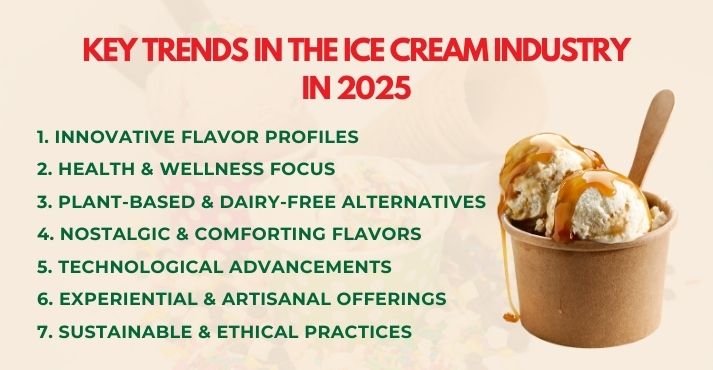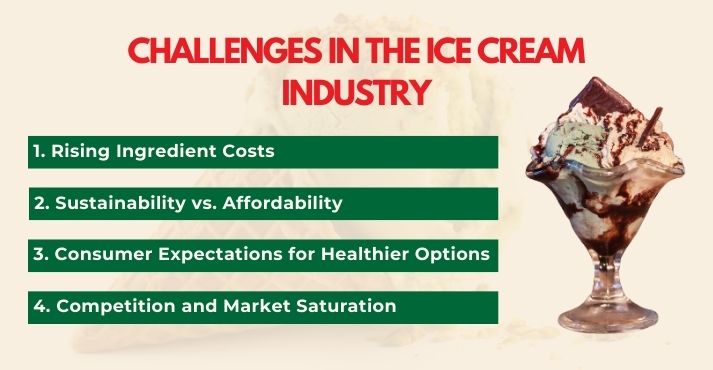Ice cream remains a favorite treat worldwide, but people’s expectations are changing. While classics like vanilla and chocolate still dominate, many consumers are drawn to new flavors, plant-based options, and even ice creams with added health benefits.
Some consumers seek low-sugar or high-protein varieties, while others prefer rich, indulgent textures. Brands are responding by developing innovative products that cater to different tastes and dietary preferences.
Following global ice cream trends helps businesses stay competitive in a fast-changing market. More people care about natural ingredients, sustainable packaging, and ethical sourcing.
Nostalgia is also influencing choices, with brands bringing back childhood favorites alongside adventurous new combinations. Ice cream in 2025 is about more than just taste—it reflects lifestyle changes, health goals, and environmental awareness.
The Current Landscape of the Global Ice Cream Market

The ice cream industry continues to grow, with new flavors, ingredients, and production methods influencing consumer choices. The market is set to reach $44.69 billion in 2025, up from $42.07 billion in 2024, with a CAGR of 6.2%.
Many consumers are looking for healthier options, such as low-sugar, high-protein, or dairy-free alternatives. At the same time, premium and experimental flavors are gaining popularity, increasing interest in unique flavors.
Ethical sourcing and sustainability have become more important to buyers, influencing market trends.
Meanwhile, external factors like climate change and ingredient availability are affecting production. Unstable weather impacts dairy farming and the supply of essential ingredients like vanilla and cocoa.
Companies are using technology, automation, and AI to improve efficiency and develop innovative textures and flavors to stay competitive. As consumer preferences change, businesses adapt their strategies to meet new expectations.
Key Trends in the Ice Cream Industry in 2025

The ice cream industry is seeing bolder flavors, healthier ingredients, and sustainable choices. Consumers want unique taste experiences while being mindful of nutrition and ethical sourcing.
Trends indicate more significant interest in plant-based, low-sugar, and functional ingredients. At the same time, technology is improving production efficiency and product quality, making ice cream more accessible and innovative than ever.
1. Innovative Flavor Profiles
Consumers are open to bolder flavors, with 75% of global consumers interested in trying new and exciting ice cream experiences. This curiosity has led to a rise in exotic and unexpected combinations.
While classics like vanilla and chocolate remain staples, flavors influenced by global cuisines, such as Japanese yuzu, Thai pandan, and Middle Eastern saffron, are appearing more frequently.
Spicy, floral, and umami-infused options like chili mango, lavender honey, and miso caramel are also appearing on menus and store shelves.
Brands are responding to this demand with creative new offerings. Talenti Gelato Layers is introducing Italian Tiramisu, Chocolate Chip Cookie Batter, and Snickerdoodle Cookie flavors, each featuring five layers of gelato and mix-ins.
Meanwhile, Breyers is launching a S’mores Campfire Collection, which includes ice cream, a bar, and a sandwich featuring toasted marshmallows, graham crackers, and Hershey’s chocolate.
Another emerging trend is savory ice cream, where ingredients like cheese, balsamic vinegar, and black garlic add complexity. Limited-edition and region-specific flavors create excitement and exclusivity, making customers more eager to try new varieties.
These ice cream industry trends highlight how brands cater to adventurous palates by experimenting with bold and unexpected ingredient pairings.
2. Health and Wellness Focus
More people are looking for nutritious ice cream options that fit their lifestyles. Low-sugar, high-protein, and gut-friendly varieties are becoming mainstream. Ingredients like prebiotics and probiotics are making their way into ice cream, appealing to those focused on gut health.
Consumers are also seeking added benefits, such as collagen for skin health, fiber for digestion, and adaptogens like ashwagandha to support stress relief.
Portion control is another consideration, with brands offering mini cups and lower-calorie servings for mindful indulgence. Ice cream made with natural sweeteners like monk fruit and stevia is gaining popularity, providing sweetness without artificial additives.
Functional ingredients such as immune-boosting vitamins and antioxidants are also appearing in premium health-focused products.
3. Plant-Based and Dairy-Free Alternatives
The demand for dairy-free ice cream continues to rise, with oat, almond, and coconut bases leading the way. Vegan and lactose-intolerant consumers are looking for creamy, indulgent alternatives that do not sacrifice taste or texture.
The global vegan ice cream market was valued at $701.7 million in 2024 and is projected to reach $1,027.4 million by 2033, growing at a 4.3% CAGR.
Cashew and macadamia nut-based ice creams are also becoming more popular, offering a rich, buttery texture. Brands are experimenting with pea protein and fava bean-based ice creams to create plant-based options that closely mimic traditional dairy.
One example is Cado, the first brand to make avocado-based ice cream. Unlike other vegan options, Cado’s ice cream is free from nuts and soy, making it a great alternative for allergy sufferers.
Sustainable ingredient sourcing, such as regeneratively farmed oats and organic coconut, is receiving more attention as consumers seek ethical choices that align with their values.
4. Nostalgic and Comforting Flavors
Classic flavors are making a strong comeback as consumers seek familiar, childhood-inspired treats. The rise of nostalgic flavors reflects a renewed preference for comfort foods, with ice cream brands reintroducing old favorites with a modern twist.
In fact, 62% of Gen Z consumers (and 57% of all consumers) are interested in nostalgic desserts, reinforcing the demand for flavors that evoke fond memories.
Flavors like birthday cake, cookies and cream, and Neapolitan are being revamped with high-quality ingredients and unique textures. Some brands are adding swirls of caramel, crunchy cereal pieces, or infused honey to enhance traditional flavors.
Additionally, flavors inspired by classic desserts, such as banana pudding, apple pie, and s’mores, resonate with consumers. This trend highlights the balance between nostalgia and innovation as gelato and ice cream brands create modern takes on beloved favorites.
These evolving flavor trends will be a major highlight at the upcoming gelato trade show.
5. Technological Advancements in Production
Technology is essential in improving texture, flavor consistency, and production efficiency. AI-powered formulations help brands create smooth, creamy textures with fewer artificial stabilizers, while precision freezing techniques enhance the mouthfeel of ice cream.
Another exciting development is the rise of self-serve ice cream vending machines. These machines rely on advanced refrigeration systems to maintain product quality while allowing customers to personalize their flavors and mix-ins instantly.
Automated production lines also make producing customized and limited-edition flavors easier, catering to the demand for unique and seasonal offerings. These advancements reflect trends in ice cream, where efficiency and personalization go hand in hand.
Singapore-based Happy Ice has introduced a new twist to ice cream vending with arcade-style claw machines. Customers pay between $2.50 and $3 per game and are guaranteed at least one ice cream per play — sometimes even two.
The machines, designed in-house, are placed in malls and recreational spots. Happy Ice plans to expand into Malaysia and implement cashless payment options, showcasing the intersection of automation, entertainment, and convenience in ice cream retail.
6. Experiential and Artisanal Offerings
Ice cream is no longer just a dessert—it’s an experience. High-end brands and boutique ice cream shops are turning ice cream into a luxury product by focusing on artisanal production methods and interactive experiences.
Personalized flavors, such as made-to-order nitrogen ice cream, allow customers to create different combinations on the spot. Companies like Creamistry and Sub Zero Ice Cream have built their brands around this high-tech, engaging approach.
Some brands are experimenting with layered textures, like crispy, chewy, or aerated ice creams, which add an exciting element to each bite.
Ice cream’s visual appeal is also changing. Bold colors, edible glitter, and Instagram-worthy designs are attracting younger consumers.
7. Sustainable and Ethical Practices
As more consumers seek eco-friendly and ethically sourced products, sustainability is becoming a significant focus for ice cream brands.
The ice cream packaging market is projected to reach USD 1,435.25 million by 2034, expanding from USD 949.31 million in 2025 at an annual growth rate of 4.7%. This growth rate shows the increased demand for sustainable solutions.
To reduce waste, companies are using compostable and biodegradable packaging instead of traditional plastic tubs. Ingredient sourcing is also under scrutiny, with brands opting for fair-trade vanilla, organic dairy, and plant-based alternatives with a lower environmental impact.
Some companies are even upcycling food waste by using surplus fruit or spent coffee grounds to create sustainable flavors.
Challenges in the Ice Cream Industry

While the ice cream industry continues to grow, it faces several challenges that impact production, pricing, and consumer preferences.
Rising ingredient costs, sustainability concerns, and changing health trends are forcing businesses to adapt and innovate. At the same time, increased competition means brands must find ways to stand out in a crowded market.
Addressing these challenges requires balancing quality, affordability, and innovation.
Companies must navigate economic pressures, changing consumer demands, and environmental concerns while maintaining the taste and texture that make ice cream a beloved treat.
1. Rising Ingredient Costs
Inflation and supply chain disruptions have made ingredients more expensive and harder to source. Essential ice cream components like dairy, vanilla, cocoa, and stabilizers have seen price increases, leading to higher production costs.
Weather conditions affecting cocoa and dairy supply chains have also contributed to price volatility.
To manage these costs, brands are reformulating recipes, using alternative ingredients, or adjusting portion sizes without compromising quality.
Some are opting for locally sourced ingredients to reduce transportation costs, while others are investing in efficiency-driven production technologies.
2. Sustainability vs. Affordability
Consumers want eco-friendly packaging and ethically sourced ingredients, but sustainable options often come at a higher cost. Recyclable, biodegradable, or compostable packaging materials are more expensive than conventional plastic, creating a dilemma for businesses.
Some brands are partnering with suppliers to develop cost-effective solutions to balance sustainability and affordability.
Others are introducing refillable or reusable ice cream containers, which appeal to environmentally conscious consumers while reducing long-term packaging expenses.
3. Consumer Expectations for Healthier Options
Health-conscious consumers demand low-sugar, high-protein, and dairy-free alternatives, but it is challenging to create these products without sacrificing flavor and texture.
Reducing sugar can affect creaminess and overall mouthfeel, while alternative sweeteners sometimes leave an aftertaste.
Additionally, clean-label products made with minimal and recognizable ingredients are in high demand.
While natural stabilizers and emulsifiers can be more expensive or complex to work with than artificial additives, options like sorbets and sherbets often require fewer additives, making them a simpler and more transparent choice for health-conscious consumers.
Brands must strike a balance between health benefits, ingredient transparency, and taste to keep customers satisfied.
4. Competition and Market Saturation
The ice cream market is becoming more competitive as new artisanal brands, global companies, and niche players enter. Consumers can now access a broader variety of flavors, dietary options, and premium offerings.
Businesses must differentiate through distinct flavors, limited-edition releases, or engaging brand experiences.
Some focus on hyper-local sourcing, while others create interactive in-store experiences to build customer loyalty. Innovation and branding are critical in standing out in this crowded market.
Conclusion
The ice cream industry in 2025 focuses on innovation, health-conscious choices, and sustainability. Consumers are looking for bold flavors, wholesome ingredients, and ethically sourced products, leading brands to rethink how ice cream is made and enjoyed.
From exotic blends to dairy-free options and nostalgic classics, companies are adjusting to changing tastes. Those focusing on technology, clean-label recipes, and sustainability will stand out in the market.
Balancing quality, affordability, and experience will be important in a competitive space. The future of ice cream isn’t just about what’s in the scoop—it’s about how it’s made, served, and shared.













